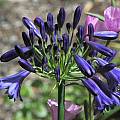Members of the PBS list discussed their favorite blue flowered bulbs in November 2004. There was some carry over from the purple favorites, considered blue by some and purple by others. Participants mentioned the bulbs listed below as favorites. They are listed alphabetically, sometimes with comments, followed by the name and the location of the person who named them as favorite, usually from experience growing them. If we have a picture of the plants mentioned on the wiki there is a link to that picture with the name of the photographer included in the text under the photo. One member also mentioned his favorite turquoise or teal flowers and we have created a page for them. This page contains genera A -H.
See favorite blue I-Z - Favorite Turquoise Bulbs for other favorite blue bulbs.
Agapanthus -- some lovely deep violet-blue agapanthus such as 'Stormy Seas', Kathy Stokmanis, Sierra foothills, Northern California; 'Bressingham Blue' is a pretty good deep true blue. It's a rather small cultivar, perhaps 75 cm high or so, but considerably hardier than many of the big agapanthus -- Rodger Whitlock, Victoria, British Columbia, Canada
Anemone blanda -- mixed blue shades run the range from a medium pale true blue through deep blue and pale ice blue, but all are harmonious and blend beautifully, blooming from early to late and extending their own season this way, Jim Waddick, Kansas City, Missouri.
Aristea bakeri -- has survived our dry summer just fine in the ground so it looks like a keeper and I thought the flowers a nice color of blue when it bloomed this spring, Mary Sue Ittner, California's North Coast.
Aristea ecklonii -- I love this in flower under trees when it is grown well en masse. Lots of small sparkling blue stars amidst a deep green field of leaves. Lee Poulsen, Southern California, USDA Zone 9-10.
Babiana disticha (syn. Babiana fragrans) -- a pale blue with darker blue markings and a lovely perfume. Sheila Burrow, Perth, Western Australia.
Bellevalia dubia -- has nice blue buds when it first starts to bloom and then becomes brown. Mary Sue Ittner, California's North Coast
Caladenia -- beautiful blue species terrestrial orchids from Australia -- Tsuh Yang Chen. This reference probably refers to some species previously in this genus, but now moved to Cyanicula.
Camassia is a nice blue Kathy Stokmanis, Sierra foothills, Northern California.
Commelina tuberosa (aka C. coelestis) -- sparkling, intense blue. This one grown from root clusters which will remind you of those of a turban ranunculus. -- Jim McKenney, Montgomery County, Maryland.
Conanthera species, especially , Bill Dijk, Tauranga, New Zealand.
Crocus adamii -- this endemic (I think) to the Greater Caucasus Mountains comes in a delightful shade of blue with varying shades of gray feathering the outside of the petals. Boyce Tankersley, Illinois.
Cypella coelestis (syn. Phalocallis coelestis, Cypella plumbea) -- This one isn't completely true blue, but is such a ghostly stunning color of sky blue with a hint of lavender when seen in person that it has to go on the list. Lee Poulsen, Southern California, USDA Zone 9-10.
Delphinium -- Delphinium decorum and Delphinium paryii are almost blue or part blue. There is an unknown species I grew from seed that is really a gorgeous color of blue. Mary Sue Ittner, California's North Coast. This latter also nominated as true blue by Lee Poulsen, Southern California, USDA Zone 9-10.
Delphinium tricorne -- This is a local native. Flower color varies, but it can be very good. Jim McKenney, Montgomery County, Maryland.
Geissorhiza species, especially Geissorhiza radians -- Bill Dijk, Tauranga, New Zealand.
Gelasine elongata (syn G. azurea) Bill Dijk, Tauranga, New Zealand.
Griffinia species are small, but fun. And on to the biggies like Griffinia hyacinthina--Kevin Preuss, Florida.
Herbertia -- species including Herbertia pulchella, a special, particular dark blue nicely shaped form of a real treasure, Bill Dijk, Tauranga, New Zealand.
Hyacinthoides lingulata syn. Scilla lingulata -- The strain that Harold Koopowitz brought to one of Cathy Craig's get-togethers, was a wonderful shade of blue. Lee Poulsen, Southern California, USDA Zone 9-10.






















